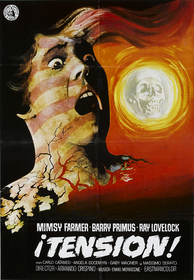Our editor-in-chief Nate Yapp is proud to have contributed to the new book Hidden Horror: A Celebration of 101 Underrated and Overlooked Fright Flicks, edited by Aaron Christensen. Another contributors include Anthony Timpone, B.J. Colangelo, Dave Alexander, Classic-Horror.com's own Robert C. Ring and John W. Bowen. Pick up a copy today from Amazon.com!
Autopsy (1975)
Originally titled Macchie Solari (Sunspots), and retitled Autopsy by its American distributors, Armando Crispino's giallo has long been available on video, but little seen by the American audience. Anchor Bay's recent restoration and re-release on DVD and video has again brought this film to back into the spotlight, revealing a taught, beautiful, and grisly giallo.
A wave of solar activity (hence the Italian title) is causing an outbreak of violence and suicide in Rome. This unfortunate occurrence is a boon to a young medical student, played by the lovely Mimsy Farmer. She is writing her thesis on the differences between real suicides and disguised murders. At the beginning of the film, we find her strung out, and near collapse after working tirelessly in the city morgue. Sent home after a creepy, walking-cadaver hallucination, she is confronted by an American tourist with a dark secret. When the woman turns up the next day on a slab at the morgue, Ms. Farmer is pulled into a tangled and lethal mystery.
From here, we meet a number of characters/suspects, including her boyfriend (English actor Ray Lovelock, the hippie hero of The Living Dead at Manchester Morgue), her father (Carlo Cattaneo), and a violent, fast-driving priest (Barry Primus, in a terrifically whacked-out performance) who is brother (and Father) to the dead woman.
Like most gialli, the plot is convoluted and contrived, and the mystery unsolvable. Much is made of Mimsy Farmer's obsession with death, sexual frigidity, and ambiguous relationship with her father, but director Crispino is little interested in subtext and motivation. Of course, one doesn't watch a film like this for the story and theme, but rather the cinematography, graphic violence, and over-the-top acting. Autopsy doesn't disappoint in any of these areas.
Shot in Rome on a decent budget, Autopsy is a great film to look at. The colors are rich and vibrant. The camera work and editing, while not on par with Dario Argento, effectively conveys the lead character's paranoia and disorientation.
There is little onscreen carnage after the opening suicide montage. To make up for it, director Crispino gives us good, long looks at Mimsy's research subject: cold, black-and-white photos of crime scenes, autopsies, and medical anomalies. While arguably a cheap ploy, these are real, grotesque, and sometimes strangely beautiful, and give the film an understated feeling of unease that a dozen fake splatter scenes couldn't equal.
The good folks at Anchor Bay have done it again, rescuing this terrific little film from obscurity. It has a great 70's Euro atmosphere: the ancient architecture of Rome, car chases, and decadent sexuality. While it echoes some of Italian maestro Dario Argento's early film, Autopsy strikes out its own territory, a with distinct atmosphere of paranoia and creepy thrills.
A Note on other Autopsies: a number of films were released in the early seventies under the title Autopsy: this film, Macchie Solari; the Spanish gore film by director Juan Logar; as well as a short documentary titled "Seeing with ones Own Eyes" (the literal translation of the Greek 'autopsy'). They are often confused. Scenes from one of these films turned up in the infamous Faces of Death 2. While it has been often attributed to Macchie Solari, the footage is, in fact, taken from the Spanish film.








